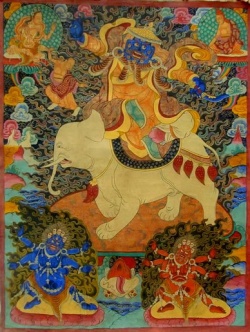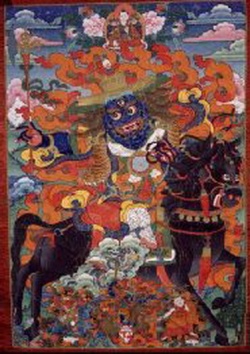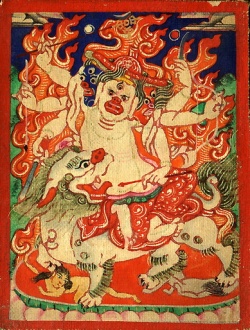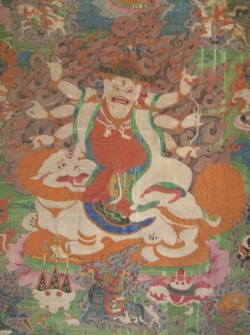Difference between revisions of "Pehar"
| Line 4: | Line 4: | ||
[[File:Pehar023.jpg|thumb|250px|]] | [[File:Pehar023.jpg|thumb|250px|]] | ||
| − | ===[[Nyingma | + | |
| + | |||
| + | ===[[Nyingma Protector]]=== | ||
| Line 10: | Line 12: | ||
[[Pehar]] was originally a [[Nyingma protector]], but was adopted into [[Gelugpa]] [[practice]]. | [[Pehar]] was originally a [[Nyingma protector]], but was adopted into [[Gelugpa]] [[practice]]. | ||
| − | Important Guardian who [[manifests]] through a [[spirit]] {{Wiki|medium}} to advise the [[Dalai Lama]] and his government. | + | Important [[Guardian]] who [[manifests]] through a [[spirit]] {{Wiki|medium}} to advise the [[Dalai Lama]] and his government. |
| − | Many [[eons]] ago, the [[dharma protector]], [[Pehar]], was a | + | Many [[eons]] ago, the [[dharma protector]], [[Pehar]], was a [[royal prince of the Ashuras]] called [[Damaraja]]. |
At the [[time]] of his [[birth]], another boy was also born -- to one of the king's ministers. | At the [[time]] of his [[birth]], another boy was also born -- to one of the king's ministers. | ||
| Line 18: | Line 20: | ||
The two became fast friends and were [[ordained]] as [[monks]] together by the [[abbot]] called Dawe ([[moonlight]].) | The two became fast friends and were [[ordained]] as [[monks]] together by the [[abbot]] called Dawe ([[moonlight]].) | ||
| − | [[Damaraja's]] [[religious | + | [[Damaraja's]] [[religious name]] was [[Dawe Shinu]] and his friend's was [[Tunten Nagpo]]. |
| Line 26: | Line 28: | ||
One day [[Dawe Shinu]] went to visit a [[Hindu]] [[Temple]] where he met a beautiful girl named [[Zitan Metog Ke]]. Overwhelmed by [[physical]] [[attraction]], they fell into each other's arms and ended up making [[love]] in the [[temple]] for 7 days and nights. | One day [[Dawe Shinu]] went to visit a [[Hindu]] [[Temple]] where he met a beautiful girl named [[Zitan Metog Ke]]. Overwhelmed by [[physical]] [[attraction]], they fell into each other's arms and ended up making [[love]] in the [[temple]] for 7 days and nights. | ||
| − | |||
[[Dawe Shinu]] had broken his [[vows]] of [[celibacy]]. | [[Dawe Shinu]] had broken his [[vows]] of [[celibacy]]. | ||
| − | |||
His [[friend]] came and tried to stop them, but he could do [[nothing]]. | His [[friend]] came and tried to stop them, but he could do [[nothing]]. | ||
| Line 36: | Line 36: | ||
If it had not been for [[Vajrapani]], who protected [[Tunten Nagpo]] with his [[vajra]], he would have done so. | If it had not been for [[Vajrapani]], who protected [[Tunten Nagpo]] with his [[vajra]], he would have done so. | ||
| − | |||
| − | |||
Years late, when [[Dawe Shinu]] [[died]], he was [[reborn]] in [[hell]]. | Years late, when [[Dawe Shinu]] [[died]], he was [[reborn]] in [[hell]]. | ||
| − | There, he was known as Butcher's | + | There, he was known as [[Butcher's Horse]], and his [[life]] was full of [[suffering]]. |
In his next [[existence]], he was [[reborn]] as a [[human being]] who was very poor and {{Wiki|homeless}}. | In his next [[existence]], he was [[reborn]] as a [[human being]] who was very poor and {{Wiki|homeless}}. | ||
One day, as he was wandering he ran into his former [[friend]] but they had no liking for each other. | One day, as he was wandering he ran into his former [[friend]] but they had no liking for each other. | ||
| − | |||
| − | |||
Then [[Dawe Shinu]] was born to [[King]] [[Muche Tsampo]] and his wife, {{Wiki|Queen}} [[Lhamo Tongon]]. that [[time]], he was named [[Vajra]] Kuhe Samati. | Then [[Dawe Shinu]] was born to [[King]] [[Muche Tsampo]] and his wife, {{Wiki|Queen}} [[Lhamo Tongon]]. that [[time]], he was named [[Vajra]] Kuhe Samati. | ||
| Line 84: | Line 80: | ||
[[Pehar]], as a [[dharmapala]], [[embodies]] the [[activities]] of the [[Five Buddhas]]. | [[Pehar]], as a [[dharmapala]], [[embodies]] the [[activities]] of the [[Five Buddhas]]. | ||
| − | |||
| − | + | ===He also has [[five aspects of Pehar]]:=== | |
| + | |||
| + | |||
| + | |||
| + | <poem> | ||
| + | [[Body]], | ||
| + | [[Mind]], | ||
| + | [[Speech]], | ||
| + | [[Knowledge]] and | ||
| + | [[Activity]]. | ||
| + | </poem> | ||
| + | |||
| + | |||
| + | The [[Mind aspect of King Pehar]] ([[Tuk ki Gyalpo]]) is brown with one face and two arms. | ||
| − | His right hand holds a red {{Wiki|spear}}, his left, a double-edged sword and a lasso. | + | His right hand holds a [[red]] {{Wiki|spear}}, his left, a double-edged sword and a lasso. |
He wears a bear {{Wiki|skin}} shawl and a black turban and is seated on an [[elephant]] amidst [[fire]]. | He wears a bear {{Wiki|skin}} shawl and a black turban and is seated on an [[elephant]] amidst [[fire]]. | ||
| Line 96: | Line 104: | ||
| − | The [[Body | + | The [[Body aspect of Pehar]] ([[Kui Gyalpo]]) is [[dark blue]], with one face and two arms. |
His right hand holds a [[vajra]] and his left, a single [[cymbal]]. | His right hand holds a [[vajra]] and his left, a single [[cymbal]]. | ||
| Line 103: | Line 111: | ||
| − | The [[Knowledge]] | + | The [[Knowledge aspect]] ([[Yonten kyi Gyalpo]]) is black, with one face and two arms. |
His right hand holds an axe, his left a demon's lasso. | His right hand holds an axe, his left a demon's lasso. | ||
| Line 111: | Line 119: | ||
| − | The [[Speech]] | + | The [[Speech aspect]] ([[Sung gi Gyalpo]]) is dark brown, with one face and two arms. |
His right hand holds a [[staff]], his left a {{Wiki|sandalwood}} club. | His right hand holds a [[staff]], his left a {{Wiki|sandalwood}} club. | ||
| Line 119: | Line 127: | ||
| − | The [[Activity]] | + | The [[Activity aspect]] ([[Thinley gyi Gyalpo]]) is navy blue with three faces and six arms. |
His first right hand holds a hook, the second an arrow, and the third, a sword. | His first right hand holds a hook, the second an arrow, and the third, a sword. | ||
| Line 127: | Line 135: | ||
He wears his [[tipshu]], a white shawl and leopard-skin skirt, and rides a [[snow lion]]. | He wears his [[tipshu]], a white shawl and leopard-skin skirt, and rides a [[snow lion]]. | ||
| − | ~ edited from [[Lama]] [[Kunga Rinpoche's]] [[teaching]] (02/1999) as recorded by Jeff Watt. | + | ~ edited from [[Lama]] [[Kunga Rinpoche's]] [[teaching]] (02/1999) as recorded by [[Jeff Watt]]. |
[[Pehar]] remained at [[Samye]] for 7 centuries. | [[Pehar]] remained at [[Samye]] for 7 centuries. | ||
| Line 133: | Line 141: | ||
| − | === | + | ===[[How Pehar Came to Nechung]]=== |
| − | The text on the back of [[Wisdom Publications]] [[calendar]] for 1996, which has a depiction of [[Pehar]] in the [[Gelugpa]] context, states that this "[[state | + | The text on the back of [[Wisdom Publications]] [[calendar]] for 1996, which has a depiction of [[Pehar]] in the [[Gelugpa]] context, states that this "[[state oracle Tibet]]," is one of the [[five Gyepo kunga]], or [[Gyepo spirits]]. |
| Line 149: | Line 157: | ||
![[name]] !! {{Wiki|color}}!! mount !! [[king]] of | ![[name]] !! {{Wiki|color}}!! mount !! [[king]] of | ||
|- | |- | ||
| − | |[[Indra]]|| dark blue || [[elephant]] ||[[mind]] ([[thuk]]) | + | |[[Indra]]|| [[dark blue]] || [[elephant]] ||[[mind]] ([[thuk]]) |
|- | |- | ||
| − | |[[Monbuputra]] || black || white lioness || [[body]] [[ | + | |[[Monbuputra]] || black || white lioness || [[body]] [[ku]]) |
|- | |- | ||
|[[Shingjachen]] || black || black [[horse]] || [[virtue]] ([[yonten]]) | |[[Shingjachen]] || black || black [[horse]] || [[virtue]] ([[yonten]]) | ||
|- | |- | ||
| − | |[[Kyechikpu]] || red || black mule || [[speech]] ([[sung]]) | + | |[[Kyechikpu]] || [[red]] || black mule || [[speech]] ([[sung]]) |
|- | |- | ||
|[[Pehar]] || white || white [[lion]] || [[activity]] ([[tinley]]) | |[[Pehar]] || white || white [[lion]] || [[activity]] ([[tinley]]) | ||
| Line 166: | Line 174: | ||
| − | [[Pehar]] was [[Uigur]] in origin -- the [[yidam | + | [[Pehar]] was [[Uigur]] in origin -- the [[yidam of the Hor tribal people]]. |
We have seen above how he was established at [[Samye]] as its [[guardian]]. | We have seen above how he was established at [[Samye]] as its [[guardian]]. | ||
| Line 172: | Line 180: | ||
Then, during the reign of the [[Fifth Dalai Lama]] (1617-1682) he moved to [[Nechung]] near [[Drepung Monastery]]. | Then, during the reign of the [[Fifth Dalai Lama]] (1617-1682) he moved to [[Nechung]] near [[Drepung Monastery]]. | ||
| − | However, [[tradition]] holds that he had long before promised to be a [[student | + | However, [[tradition]] holds that he had long before promised to be a [[student of Tsong Khapa]] (1357-1419) and that he was a [[disciple]] of the [[abbot]] of [[Drepung]] a good 200 years before the reign of the "[[Great Fifth]]." |
| − | [[Pehar]] became the "[[state | + | [[Pehar]] became the "[[state oracle of Tibet]]" in the following way: |
| − | Once, a casket drifting down the Kyichu [[River]] reached the neighbourhood of [[Drepung monastery]]. | + | Once, a casket drifting down the [[Kyichu]] [[River]] reached the neighbourhood of [[Drepung monastery]]. |
As it floated by, one of the four [[abbots]] spied it, and had the [[realization]] that [[Pehar]] was imprisoned in it. | As it floated by, one of the four [[abbots]] spied it, and had the [[realization]] that [[Pehar]] was imprisoned in it. | ||
| Line 192: | Line 200: | ||
From that [[time]] on, [[Pehar]] began to [[manifest]] through the [[speech]] of one of the [[lamas]] at [[Nechung]]. | From that [[time]] on, [[Pehar]] began to [[manifest]] through the [[speech]] of one of the [[lamas]] at [[Nechung]]. | ||
| − | The man whose [[body]] [[Pehar]] possessed was appointed the [[State]] | + | The man whose [[body]] [[Pehar]] possessed was appointed the [[State Oracle]]. |
{{R}} | {{R}} | ||
[http://www.khandro.net/deity_wrathful_Pehar.htm www.khandro.net] | [http://www.khandro.net/deity_wrathful_Pehar.htm www.khandro.net] | ||
{{NewSourceBreak}} | {{NewSourceBreak}} | ||
'''[[Pehar]]''' (Tib. {{BigTibetan|[[པེ་ཧར]]་}}, [[Wyl.]] ''[[pe har]]''), the leader of the [[gyalpo]], is the [[spirit]] channeled by the [[Nechung Oracle]]. | '''[[Pehar]]''' (Tib. {{BigTibetan|[[པེ་ཧར]]་}}, [[Wyl.]] ''[[pe har]]''), the leader of the [[gyalpo]], is the [[spirit]] channeled by the [[Nechung Oracle]]. | ||
| + | |||
==Further Reading== | ==Further Reading== | ||
| − | {{Nolinking|*Dan Martin, "The Star King and the Four Children of Pehar: Popular Religious Movements of 11th- to 12th-Century Tibet", Acta Orientalia Academiae Scientiarum Hung. XLIX: 1-2 (1996) | + | |
| − | *Lin Shen-Yu: | + | |
| + | {{Nolinking|*Dan Martin, "The Star King and the Four Children of [[Pehar]]: Popular Religious Movements of 11th- to 12th-Century Tibet", [[Acta Orientalia]] Academiae Scientiarum Hung. XLIX: 1-2 (1996) | ||
| + | |||
| + | *Lin Shen-Yu: “[[Pehar]]: A Historical Survey” in ''Revue d’Etudes Tibétaines '' 19, 2010 Available online [http://himalaya.socanth.cam.ac.uk/collections/journals/ret/pdf/ret_19_01.pdf here]}} | ||
==External Links== | ==External Links== | ||
| + | |||
| + | |||
*[http://www.himalayanart.org/search/set.cfm?setID=473 Pehar at Himalayan Art] | *[http://www.himalayanart.org/search/set.cfm?setID=473 Pehar at Himalayan Art] | ||
{{RigpaWiki}} | {{RigpaWiki}} | ||
{{NewSourceBreak}} | {{NewSourceBreak}} | ||
| + | |||
[[File:Nechung Gompa.jpg|thumb|Representation of Pehar Gyalpo at Nechung Gompa, in Tibet]] | [[File:Nechung Gompa.jpg|thumb|Representation of Pehar Gyalpo at Nechung Gompa, in Tibet]] | ||
| − | According to [[Tibetan Buddhism|Tibetan Buddhist]] [[myth]], '''[[Gyalpo Pehar]]''' ({{bo|t={{BigTibetan|[[རྒྱལ་པོ་དཔེ་ཧར]]}} |w=[[rgyal po dpe har]]}} [also spelt: ''[[pe kar]]'' & ''[[dpe dkar]]'']) is a [[spirit]] belonging to the [[Gyalpo spirits|gyalpo]] class. When [[Padmasambhava]] arrived in [[Tibet]] in the eighth century, he subdued all [[gyalpo | + | According to [[Tibetan Buddhism|Tibetan Buddhist]] [[myth]], '''[[Gyalpo Pehar]]''' ({{bo|t={{BigTibetan|[[རྒྱལ་པོ་དཔེ་ཧར]]}} |w=[[rgyal po dpe har]]}} [also spelt: ''[[pe kar]]'' & ''[[dpe dkar]]'']) is a [[spirit]] belonging to the [[Gyalpo spirits|gyalpo]] class. |
| + | |||
| + | When [[Padmasambhava]] arrived in [[Tibet]] in the eighth century, he subdued all [[gyalpo spirits]] and put them under control of [[Gyalpo Pehar]], who promised not to harm any [[sentient beings]] and was made the [[chief guardian spirit of the Samye Temple]] built at that [[time]]. | ||
| + | |||
| + | Some [[Tibetans]] believe that the [[protector of Samye]] sometimes enters the [[body]] of a {{Wiki|medium}} (called the "[[Dharma Lord of Samye]]") and acts as an {{Wiki|oracle}}. | ||
| + | |||
| + | <ref>{{Nolinking|Shabkar Tsogdruk Rangdrol; [[Matthieu Ricard]] (trans); Constance Wilkinson, Michal Abrams (eds) (1994). The life of Shabkar. SUNY Press. ISBN 978-0-7914-1835-2. p. 272}}</ref> | ||
{{Reflist}} | {{Reflist}} | ||
==External links== | ==External links== | ||
| − | * [http://www.himalayanart.org/search/set.cfm?setID=473 Buddhist Worldly Protector: Pehar] - at HimalayanArt.org | + | |
| + | * [http://www.himalayanart.org/search/set.cfm?setID=473 [[Buddhist Worldly Protector]]: [[Pehar]] - at HimalayanArt.org | ||
* [http://www.himalayanart.org/image.cfm/213.html Deity King Pehar] | * [http://www.himalayanart.org/image.cfm/213.html Deity King Pehar] | ||
* [http://www.khandro.net/deity_wrathful_Pehar.htm Pehar] | * [http://www.khandro.net/deity_wrathful_Pehar.htm Pehar] | ||
| Line 218: | Line 240: | ||
[[Wikipedia:Gyalpo Pehar]] | [[Wikipedia:Gyalpo Pehar]] | ||
{{NewSourceBreak}} | {{NewSourceBreak}} | ||
| − | [[Pehar]] or [[Pekar]]. Important Guardian who [[manifests]] through a [[spirit]] {{Wiki|medium}} to advise the [[Dalai Lama]] and his government. | + | [[Pehar]] or [[Pekar]]. Important [[Guardian]] who [[manifests]] through a [[spirit]] {{Wiki|medium}} to advise the [[Dalai Lama]] and his government. |
{{R}} | {{R}} | ||
Revision as of 13:29, 6 April 2016
Nyingma Protector
Pehar was originally a Nyingma protector, but was adopted into Gelugpa practice.
Important Guardian who manifests through a spirit medium to advise the Dalai Lama and his government.
Many eons ago, the dharma protector, Pehar, was a royal prince of the Ashuras called Damaraja.
At the time of his birth, another boy was also born -- to one of the king's ministers.
The two became fast friends and were ordained as monks together by the abbot called Dawe (moonlight.)
Damaraja's religious name was Dawe Shinu and his friend's was Tunten Nagpo.
Dawe Shinu became a scholar, who enjoyed teaching Dharma. His friend enjoyed meditating.
One day Dawe Shinu went to visit a Hindu Temple where he met a beautiful girl named Zitan Metog Ke. Overwhelmed by physical attraction, they fell into each other's arms and ended up making love in the temple for 7 days and nights.
Dawe Shinu had broken his vows of celibacy.
His friend came and tried to stop them, but he could do nothing.
Dawe Shinu got so angry at the intervention that he turned into a lion and threatened to kill his friend.
If it had not been for Vajrapani, who protected Tunten Nagpo with his vajra, he would have done so.
Years late, when Dawe Shinu died, he was reborn in hell.
There, he was known as Butcher's Horse, and his life was full of suffering.
In his next existence, he was reborn as a human being who was very poor and homeless.
One day, as he was wandering he ran into his former friend but they had no liking for each other.
Then Dawe Shinu was born to King Muche Tsampo and his wife, Queen Lhamo Tongon. that time, he was named Vajra Kuhe Samati.
His former friend, Tunten Nagpo, was a hermit who meditated in cave and for some reason, Vajra Kuhe Samati was moved to turn himself into a rat just to try and disturb him.
Once again Vajprapani intervened to protect Tunten Nagpo.
The fourth existence of Dawe Shinu was as the third son of Dudje Tsempo, king of the local demons.
His name this time was Mudu Tankhar.
(His father also had four other children.)
Pehar is a reincarnation of that demon, Mudu Tankhar.
He is described as having three faces, six arms and riding a lion.
He is known as a Tinley Gyalpo, or Action King.
When Padmasambhava and Tibetan ruler, Trison Deutsen, built Samye Monastery, Guru Rinpoche invited Pehar from his realm called Petahor to be the protector.
He gave him a wife, Mentsun Karmo, as well as another consort.
They were installed in the quarters called Peharchok that was established especially for them in the northern side of Samye.
This Pehar temple is known as the Turquoise Palace.
Pehar, as a dharmapala, embodies the activities of the Five Buddhas.
He also has five aspects of Pehar:
The Mind aspect of King Pehar (Tuk ki Gyalpo) is brown with one face and two arms.
His right hand holds a red spear, his left, a double-edged sword and a lasso.
He wears a bear skin shawl and a black turban and is seated on an elephant amidst fire.
The Body aspect of Pehar (Kui Gyalpo) is dark blue, with one face and two arms.
His right hand holds a vajra and his left, a single cymbal.
He wears a round golden cymbal-shaped hat (tipshu) and rides a black bear.
The Knowledge aspect (Yonten kyi Gyalpo) is black, with one face and two arms.
His right hand holds an axe, his left a demon's lasso.
He wears a tiger skin shawl and a black snakeskin and rides a dragon.
The Speech aspect (Sung gi Gyalpo) is dark brown, with one face and two arms.
His right hand holds a staff, his left a sandalwood club.
He wears a black robe and rides an iron wolf.
The Activity aspect (Thinley gyi Gyalpo) is navy blue with three faces and six arms.
His first right hand holds a hook, the second an arrow, and the third, a sword.
His first left hand holds a razor-sharp knife, the second a bow, the third a staff.
He wears his tipshu, a white shawl and leopard-skin skirt, and rides a snow lion.
~ edited from Lama Kunga Rinpoche's teaching (02/1999) as recorded by Jeff Watt.
Pehar remained at Samye for 7 centuries.
How Pehar Came to Nechung
The text on the back of Wisdom Publications calendar for 1996, which has a depiction of Pehar in the Gelugpa context, states that this "state oracle Tibet," is one of the five Gyepo kunga, or Gyepo spirits.
They are:
| name | color | mount | king of |
|---|---|---|---|
| Indra | dark blue | elephant | mind (thuk) |
| Monbuputra | black | white lioness | body ku) |
| Shingjachen | black | black horse | virtue (yonten) |
| Kyechikpu | red | black mule | speech (sung) |
| Pehar | white | white lion | activity (tinley) |
He bears a different name according to his function.
Pehar was Uigur in origin -- the yidam of the Hor tribal people.
We have seen above how he was established at Samye as its guardian.
Then, during the reign of the Fifth Dalai Lama (1617-1682) he moved to Nechung near Drepung Monastery.
However, tradition holds that he had long before promised to be a student of Tsong Khapa (1357-1419) and that he was a disciple of the abbot of Drepung a good 200 years before the reign of the "Great Fifth."
Pehar became the "state oracle of Tibet" in the following way:
Once, a casket drifting down the Kyichu River reached the neighbourhood of Drepung monastery.
As it floated by, one of the four abbots spied it, and had the realization that Pehar was imprisoned in it.
He ordered a priest to retrieve the casket and take it up to the monastery.
While the man was carrying the heavy container, his curiosity overwhelmed him and he set it down and opened it.
Out fluttered a white dove which flew to perch in a birch tree, but then it vanished from sight.
Nechung Monastery was constructed (1416) around the tree.
From that time on, Pehar began to manifest through the speech of one of the lamas at Nechung.
The man whose body Pehar possessed was appointed the State Oracle.
Source
Pehar (Tib. པེ་ཧར་, Wyl. pe har), the leader of the gyalpo, is the spirit channeled by the Nechung Oracle.
Further Reading
- Dan Martin, "The Star King and the Four Children of Pehar: Popular Religious Movements of 11th- to 12th-Century Tibet", Acta Orientalia Academiae Scientiarum Hung. XLIX: 1-2 (1996)
- Lin Shen-Yu: “Pehar: A Historical Survey” in Revue d’Etudes Tibétaines 19, 2010 Available online here
External Links
Source
According to Tibetan Buddhist myth, Gyalpo Pehar (Tibetan: རྒྱལ་པོ་དཔེ་ཧར, Wylie: rgyal po dpe har [also spelt: pe kar & dpe dkar]) is a spirit belonging to the gyalpo class.
When Padmasambhava arrived in Tibet in the eighth century, he subdued all gyalpo spirits and put them under control of Gyalpo Pehar, who promised not to harm any sentient beings and was made the chief guardian spirit of the Samye Temple built at that time.
Some Tibetans believe that the protector of Samye sometimes enters the body of a medium (called the "Dharma Lord of Samye") and acts as an oracle.
Footnotes
- ↑ Shabkar Tsogdruk Rangdrol; Matthieu Ricard (trans); Constance Wilkinson, Michal Abrams (eds) (1994). The life of Shabkar. SUNY Press. ISBN 978-0-7914-1835-2. p. 272
External links
- [http://www.himalayanart.org/search/set.cfm?setID=473 Buddhist Worldly Protector: Pehar - at HimalayanArt.org
- Deity King Pehar
- Pehar
Source
Pehar or Pekar. Important Guardian who manifests through a spirit medium to advise the Dalai Lama and his government.




